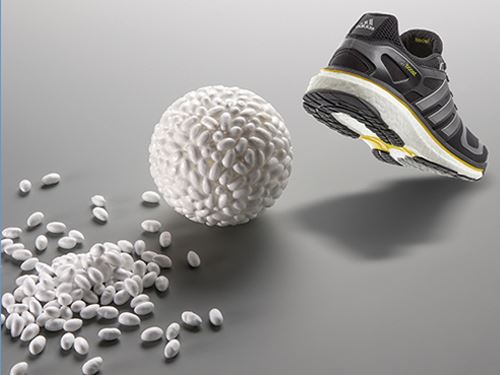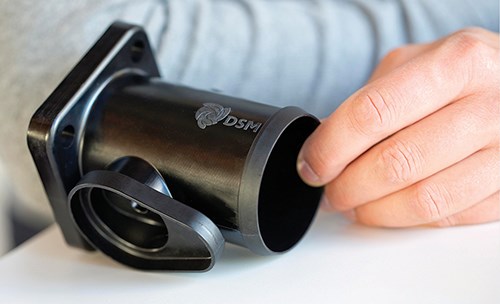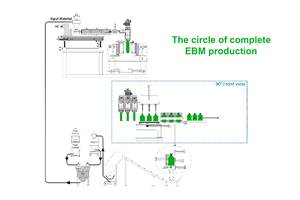K 2013 Preview: Materials & Additives
Performance, Economy & Sustainability Drive Materials & Additives Developments
The K 2013 show will present a broad range of engineered plastics materials, including thermoplastic composites, as well as additives. Automotive and electronic applications will be the main targets, as well as medical, packaging, lighting, and construction.
The K 2013 show will present a broad range of engineered plastics materials, including thermoplastic composites, as well as additives. Automotive and electronic applications will be the main targets, as well as medical, packaging, lighting, and construction.
TOUGHER, LIGHTER ENGINEERED PLASTICS
Several specialty nylon compounds, along with two unique engineered PET materials, an ultra-low-friction acetal, and reinforced PC are among the crop of new materials.
BASF Engineering Plastics (U.S. office in Florham Park, N.J.) will bring out new nylons for automotive, industrial machinery, and furniture. BASF has expanded its glass-reinforced Ultramid S Balance nylon 610 line with two new flexible extrusion grades for pipe and tubing in the automotive and machinery sectors as well as for oil and gas lines. These grades are modified for low-temperature impact strength. Grade S4Z5 is a semi-flexible material for liquid-conveying lines that must meet demanding temperature requirements. Grade S4Z4 XS is a more flexible product for vacuum and vent lines and has even greater stress-crack resistance.
Also new from BASF is a blow molding grade of Ultramid Endure, a specially stabilized nylon 66 for auto under-hood parts. With its heat resistance of 220 C in continuous use and peak temperature of 240 C, the new D5G3 BM grade (15% glass) can be used for pipes between the turbocharger and intercooler.
BASF also has a new portfolio of special Ultramid nylons for furniture. Ultramid SI (surface-improved) grades reportedly provide a high-quality surface appearance. One of the first items made with Ultramid SI is the MOVYis3 office swivel chair, which BASF developed in collaboration with furniture maker Interstuhl.
Lanxess (U.S. office in Pittsburgh) will launch new compounds based on its Durethan nylon 6. XTS1 and 2 are two series said to increase the continuous service temperatures by more than 60° C—a significant leap for under-hood applications such as intercooler and coolant lines. Nylons in the XTS2 range can withstand continuous service temperatures of up to 230 C.
DuPont Performance Polymers, Wilmington, Del., will launch a halogen-free, flame-retardant, 25% glass-reinforced nylon 66 that boasts enhanced thermal aging for electrical/electronic (E/E) applications such as insulating elements and housings for circuit breakers, contactors, transformers, and motors. It achieves V-0 at 0.4mm, half as thick as previous grades. Zytel FR95G25V0NH is said to retain 80% of its tensile strength, vs. only 50% for previous materials, at 200 C for 1000 hr.
DuPont also has non-halogen Zytel HTN FR55G50NHLW, a low-warp, 94V-0 PPA with 50% glass, which provides flatness in new ultra-thin laptops.
For automotive E/E parts, DuPont’s new Crastin HR HFS is a second-generation hydrolysis-resistant, high-flow, melt-stable PBT available with 15% and 30% glass. It’s designed to withstand long residence times in hot runners.
And for under-hood parts like charge-air coolers, DuPont’s third-generation Zytel Plus modified nylon 66 withstands 10° C higher oven aging, which is 30° higher than standard nylon 66.
For oil and gas hose and tubing, new Zytel RS LC4000 is a modified nylon 610 based largely on castor oil. A companion product is new Zytel LC 7000 modified nylon 612, which is non-renewably based but can substitute for nylon 12, which was recently subject to a worldwide shortage. Both new grades show improved hydrolytic and chemical resistance, according to DuPont.
The company also will feature a new ultra-low-friction grade of acetal for healthcare applications. Delrin SC699 contains a silicone dispersion and was recently specified by the Swiss company Ypsomed for a key component of its UnoPen disposable injector pen for insulin and other therapies.
DSM Engineering Plastics (U.S. office in Birmingham, Mich.) will launch new Stanyl ForTii T11, a grade of its unique high-temperature nylon 4T that delivers halogen-free, UL 94V-0 flame retardancy plus outstanding thermal and mechanical performance. It meets stringent regulations for printed circuit-board terminal blocks using surface-mount technology (SMT).
Also new is the first film extruded from DSM’s EcoPaXX biobased nylon 410. MF Folien GmbH in Germany produced 30-50 micron cast films for potential uses in flexible food packaging, building/construction, medical, aviation, and shipping.
DSM also will present what is reportedly the first highly hydrolysis-resistant, high-performance PET engineering compound. Arnite A-XO7455, a 50% glass-reinforced grade with a tensile strength at break of 200 MPa, retains around 90% of initial strength after 100 hr at 85 C and 85% RH, while conventional PET loses up to half its tensile strength. The new grade could open up opportunities for PET to compete with metals and more costly PPA and PPS resins in auto under-hood applications like throttle and air-control valve housings, sensors, electronic throttle control, and exhaust-gas recirculation covers.
Lanxess will introduce a PET compound, Pocan TP 555-001, as an economical alternative to specialty nylons for housings, sockets, and other components of LED light sources. It boasts superior light reflection, which remains nearly constant over time.
Reinforced PC grades for “razor-thin” laptop housings will be highlighted by Bayer MaterialScience (U.S. office in Pittsburgh). Available in a broad range of colors, they produce laptop housings that are lighter and thinner while maintaining sturdiness and safety.
SMA terpolymers with enhanced heat resistance are new from Polyscope of The Netherlands (U.S. office in Novi, Mich.). Addition of n-phenylmaleimide boosts the glass-transition temperature (Tg) to 175 C or higher. Two initial Xiran IZ grades can be used to upgrade styrenic polymers like ABS.
TPU, TPE DEBUTS
BASF Polyurethanes (U.S. office in Wyandotte, Mich.) will launch what appears to be the first expandable TPU (E-TPU) for bead foam molding. Branded Infinergy, it is based on Elastollan TPU, which is expanded using a novel method. Being a closed-cell particle foam, Infinergy has a low bulk weight, with a density of only 0.110 g/cc. After processing on standard bead molding machines, it has a molded part density of 0.20 to 0.32 g/cc, which positions it between lighter EPS or EPP and heavier PUR foams.
Infinergy absorbs little water—less than 2% by volume in 24 hr. It has very high break elongation of 100-150%, depending on density, and a combination of good abrasion and chemical resistance. One of its key features is its excellent recovery behavior, which reportedly makes it the most elastic particle foam on the market. Tests show that the rebound height of E-TPU can be as much as 55%, which is significantly higher than EPS (less than 20%) or EPP (30%). Its first commercial application is the midsole of the new Adidas “Energy Boost” running shoe.
Huntsman Polyurethanes (U.S. office in Auburn Hills, Mich.) will showcase a new line of Irogran polyether TPUs for food-contact applications such as conveyor belts, hoses, and tubes. Also highlighted by Huntsman will be Irogran A 95 P5003, a halogen-free flame-retardant TPU for wire and cable. The company will also present highly transparent and UV-stabilized additions to its Avalon TPU footwear range.
If you’re looking for alternatives to glass-reinforced TPUs, Geba Group, a German compounder of engineered plastics (geba-group.com), will showcase natural-fiber reinforced Desmovit DP R Econ N, developed with Bayer MaterialScience. It is offered with 10% and 20% natural-fiber reinforcement and has 8% lower density than glass-reinforced grades. Applications include auto underbody protection, gearshift-lever knobs, tent poles, and bicycle helmets.
PolyOne GLS Thermoplastic Elastomers, Avon Lake, Ohio, will show the latest medical-grade Versaflex HC TPE alloys. New 35 Shore A grades for infusion therapy stoppers and septums boast better self-sealing and resistance to coring than vulcanized rubbers. They also do not contain sulfur, zinc, or other cross-linking agents. They meet ISO 15759 standard for medical infusion equipment and can be steam autoclaved at up to 126 C. They also can be overmolded onto PE and PP.
Kraiburg TPE (U.S. office in Duluth, Ga.) will show off the two newest families of its styrenic TPEs for overmolding onto rigid engineering thermoplastics for consumer electronics. COPEC grades show good adhesion to ABS, PC, and PC/PBT and have 60 to 80 Shore A hardness. For-Tec E (60 Shore A) adheres to nylon 66 and semi-aromatic polyamides.
LSR ADVANCES
New liquid silicone rubber (LSR) grades will be launched by two major players for automotive seals, medical devices, and lighting. Momentive Performance Materials, Albany, N.Y., will be demonstrating its new UV-curing LSR process in cooperation with Engel and Elmet by injection molding a two-component part. Momentive says its breakthrough UV-curing LSR has expanded the range of design possibilities in multi-component injection molding because LSR can be combined with affordable, low-melting resins such as PP instead of more heat-resistant nylon and PBT.
Momentive will also feature Silopren LSR 3696/25, a new self-lubricating LSR said to provide ultra-low compression set of 19% (after 24 hr at 175 C) without post-curing. That, plus 25 A hardness and low modulus, reportedly suit it to family or mat seals in increasingly miniaturized connectors, particularly under the hood.
Also new from Momentive is a textile fiber-reinforced LSR for applications requiring very high modulus at low elongation, such as consumer electronic components, novelty products, and handles.
Wacker Chemical (U.S. office in Adrian, Mich.) will unveil an LSR for molded seals in automotive engine-cooling circuits. Elastosil LR 3022/60 ensures excellent sealing with low compression set (50% maximum) under long-term load in direct contact with coolants (1000 hr at 125 C). It also boasts excellent low-temperature flexibility down to -45C. Also from Wacker is new Lumisil LR 7600 LSR that cures “crystal clear.” Said to withstand prolonged exposure to up to 200 C, it is suitable for lenses and other optical elements in lighting.
THERMOPLASTIC COMPOSITES
At least five companies will showcase their latest advances in thermoplastic composites.
•BASF will exhibit its new Ultracom three-component TP composites package. The key component is laminates based on woven fabrics and unidirectional tapes that are fully impregnated with Ultramid nylon or Ultradur PBT. These composites are being enhanced in a developmental cooperation with composites manufacturer TenCate and glass-fiber leader Owens Corning. The second component consists of the overmolding materials—Ultramid and Ultradur compounds specially developed for use with the laminates; and the third is engineering support.
At the show, BASF will unveil the first pre-production parts and offer its first commercial Ultracom product packages. For parts of high stiffness, the package consists of an Ultralaminate based on nylon 6 (or an Ultratape if highly-directed reinforcements are needed) in combination with 60% glass-reinforced Ultramid G12 COM as an overmolding compound. For crash-loaded applications, the package is optimized for high energy absorption and consists of Ultralaminate and Ultramid ZG7 COM. Ultratape versions are offered for local reinforcement, as is required in seat structures, for example. It can be overmolded with the same Ultramide ZG7 COM.
•Bayer MaterialScience (BMS) will highlight prototype automotive structural components of PC continuous-fiber composites. According to BMS, lighting elements can be integrated into the components, which have outstanding coatability.
•Victrex (U.S. office in West Conshohocken, Pa.) will highlight new Victrex PEEK grades for aerospace and automotive, as well as medical, semiconductor, and other uses. One is PEEK HMF, a series of enhanced PEEK compounds that incorporate high-modulus carbon fibers for a boost in strength and stiffness. Addition of carbon fibers has enabled replacement of metals in aircraft system attachments, industrial machinery, and semiconductor and medical equipment.
•Lanxess will present new applications for its Tepex continuous fiber-reinforced TP composite sheet, which is now available in over 25 formulations.
•DuPont will discuss its R&D on TP composites. It is working with French automaker PSA to develop a door side-intrusion beam to replace high-strength steel. This project involves layers of dry woven glass fabric and unreinforced nylon 66 films, which are consolidated under heat and pressure using a continuous-belt laminator. The resulting sheet is preformed with heat and then overmolded in an injection machine with short-glass reinforced nylon 66 to add stiffening ribs. Metal fastener inserts are incorporated as well. DuPont is also experimenting with layup of carbon-fiber unidirectional tape prepreg with nylon 66. DuPont says it has a portfolio of composite materials in development and is doing a lot of testing to characterize design properties, such as high-speed impact resistance.
NEW POLYOLEFINS & STYRENICS
Borealis of Austria (U.S. office in Rockport, N.J.) will be presenting new PP and PE materials and applications for a variety of markets. For automotive, new Daplen L 350 HP is a high-stiffness, paintable PP for exterior parts. It boasts improved paint bonding, making possible two-layer paint systems without a third primer layer. Also, there’s a new Borstar TPO designed to eliminate flow marks in high-speed molding. This stiff material reportedly has a broad process window and provides a premium appearance due to more uniform crystallization.
For medical films and blow/fill/seal bottles, Bormed SB-815MO is a new soft PP is said to have good clarity (at least as good as LDPE) and organoleptics. It is softer than previous PPs for B/F/S bottles—more like LDPE—which allows for more complete emptying of containers. It can be sterilized at up to 121 C and reportedly offers downgauging potential of 3-4% vs. commonly used LDPE. Bormed medical grades are distributed here by Nexeo Solutions, Dublin, Ohio.
For potable water pipe, Borealis plans to introduced at K two PE grades, one a PE 80 type and the other a PE 100 (which may not be available until the end of the year). They are designed to resist higher levels and more aggressive chlorinated water disinfectants. Earlier this year, the company also came out with HE 1878E-C2, a crosslinkable HDPE for hot-water pipe.
Total of Belgium (U.S. office in Houston) has broadened its line of Lumicene PP random copolymers to an MFI range from 10 to 110 g/10 min. More transparent grades (designated MXO and MC2) have recently arrived for applications like baby bottles.
For industrial films, Total recently unveiled its second Supertough metallocene LLDPE. Grade 22ST05 (0.922 g/cc) has high impact and tear strengths, offering potential for downgauging of 10-25%. It follows by several months the introduction of the first Supertough grade, 32ST05 (0.932 density), which is stiffer.
Also new is Total’s XSene 55060 bimodal HDPE for industrial packaging like drums and IBCs. Improved ESCR, toughness, and topload strength offer potential downgauging of up to 10%.
And for construction, Total just commercialized Excell-R, a special black or gray EPS for insulating board with at least 20% better insulating properties than conventional white EPS.
MORE MATERIALS NEWS
BASF will feature its expanded product line of Ecovio compostable resin, which has proved itself in a variety of film applications. New versions include injection molding grade IS1335 and new Ecovio-based solutions for multilayer barrier films.
Styron LLC, Berwyn, Pa., will highlight its latest developments in PS, ABS/SAN, PC, and EPS. Included are materials for medical devices and housings; grades for home appliances that retain their color, gloss, and toughness; high-impact materials for consumer electronics; and, resins for building and construction that are designed for safety, strength, and sustainability.
ADDITIVES NEWS
Among the mix of new additives are two unusual introductions: an antistatic TPU and a polyol for enhancing bioplastics.
•Antistat: BASF Polyurethanes will unveil a unique addition to its Elastollan TPU product range: an antistatic TPU additive, available as a pellet masterbatch. New Elastostat’s antistatic effect is permanent and does not require any specific ambient conditions. It is said to have high compatibility with PE, PP, PS, and ABS at typical use levels of 7.5-15%. Potential applications include polyolefin industrial packaging for combustible liquids or dusty goods; anti-dust auto instrument panels, headliners, and sun visors; and electronics packaging and transport systems (e.g., trays and tablets for small electronic parts like microchips or air-bubble film bags and resealable bags for electronic devices).
•Biopolymer enhancer: Perstorp of Sweden (U.S. office in Toledo, Ohio) will launch its new Capa Thermoplastic caprolactone products for use as additives for bioplastics. The additives are said to provide superior biodegradation, easier processing, and improved mechanical properties. Capa caprolactone is a biodegradable polyester. It makes bioplastics like PLA and starch-based polymers more flexible so they elongate and stretch, instead of tearing. It also adds low-temperature toughness. Besides films, trays, and cutlery, Capa could help biopolymers penetrate durable applications such as cases for mobile phones and automotive components.
•Flame retardants: New flame retardants will be featured by at least three firms. Clariant Polymer Additives (U.S. office in Charlotte, N.C.) will emphasize the debut of its new “AddWorks” branding for this division. It also has two additions to its Exolit OP line of phosphinates for glass-reinforced thermoplastics. Grade OP 1400 is designed for reinforced nylon 6 and 66. In addition to its low density, it imparts good mechanical properties and high CTI (Comparative Tracking Index) values. Along with enhanced heat stability at high processing temperatures, it reportedly shows superior stability in hot, humid environments.
Grade OP 1260 for reinforced PET/PBT alloys is a synergistic blend that achieves UL 94V-0 at 0.8 mm thickness with only 10% loading vs. 18% for its predecessor OP 1240, while enhancing melt flow and mechanical properties.
Perstorp will unveil a new addition to its line of Charmor polyols, a rich carbon source for intumescent flame retardancy. New Charmor PM40 Care is a micronized polyol based on pentaerythritol but with a renewable raw material. It is suitable for use in thermoplastics and unsaturated polyesters.
Chemtura’s Great Lakes Solutions, W. Lafayette, Ind., will highlight its new polymeric flame retardants, the Emerald Innovation 1000 and 3000 series, described as sustainable products with minimal impact on the environment and health. The 1000 series is said to be an effective replacement for decabromodiphenyl oxide and decabromodiphenyl ethane in a wide range of polyolefin and styrenic applications, including consumer electronics, automotive, and construction. It boasts similar performance at same loadings as other high-efficiency brominated flame retardants. The 3000 flame retardant is said to offer processors of EPS and XPS an efficient, sustainable alternative to hexabromocyclododecane (HBCD).
•Pigments: Huntsman’s pigments div. (U.S. office in The Woodlands, Tex.) will feature its new Altiris infrared-reflecting, TiO2-based pigments. They minimize solar heating and warpage of dark-colored outdoor products such as PVC exterior building components.
Also new from Huntsman are Deltio low-dusting, free-flowing TiO2 pigment for bright, white polymers and Specialist Tioxide TiO2 pigments for high-performance masterbatch, films, and high-temperature PE resins.
•Liquid colors: Clariant Masterbatches will highlight a new integrated system for liquid masterbatches, custom blends of additives and pigments with carriers designed for a variety of different polymers and production processes. Recent developments have included improved liquid carriers for trouble-free extrusion blow molding of HDPE, LDPE, and PP (see Jan. 2013 Keeping Up).
PolyOne’s ColorMatrix subsidiary, Avon Lake, Ohio, will launch the latest generation of its Flex-Cart proprietary liquid dosing system, which is said to accommodate a wide range of global packaging and pump variations to help eliminate the need for additional dosing equipment. The new system offers flexibility and simplifies cleaning through easily interchangeable dosing pumps, transfer pumps, and packaging types suitable for a wide variety of applications. Improved packaging cassettes and pump connectors are said to enable quick, spill-free product changeovers without the need for tools.
•Fillers: Omya (U.S. office in Florence, Vt.) will showcase its expanded line of calcium carbonates—both Hydrocarb for extruded PVC building products and its Omyacarb and Omyafilm for film, extrusion coating, sheet, and caps/closures.
•Stabilizers: Songwon of Korea (U.S. office in Houston) is now complementing its own antioxidants and UV stabilizers with HALS UV stabilizers from Sabo SpA of Italy. Sabo produces at least seven monomeric and high-molecular-weight HALS versions. Songwon is also recently started up a plant for low-dust OPS (one-pack system) antioxidant blends in Houston, with capacity of more than 15 million lb/yr.
Clariant’s new Addworks ATR series of multifunctional stabilizers for reinforced nylons in automotive boast enhancements in processing and surface appearance.
Addivant, Middlebury, Conn., the former antioxidant and UV stabilizer business of Chemtura, plans to highlight new developments for applications ranging from food storage containers and beverage cups to auto interior components.
•Clarifiers/nucleators: Milliken Chemical, Spartanburg, S.C., will highlight new developments with its Millad NX 8000 clarifier in high-flow PP injection molding grades and its NX 8500E in PP extrusion blow molding applications such as multilayer bottles, along with new developments for its Hyperform nucleating and synthetic reinforcing agents.
Related Content
Thin, High-Performance Nylon/PE Barrier Film for Thermoformed Packaging
Südpack’s Multifol Extreme film is well suited for greasy, protein-rich and frozen foods
Read MoreBreaking the Barrier: An Emerging Force in 9-Layer Film Packaging
Hamilton Plastics taps into its 30-plus years of know-how in high-barrier films by bringing novel, custom-engineered, nine-layer structures resulting from the investment in two new lines.
Read MoreCustom Molder Pivots When States Squelch Thriving Single-Use Bottle Business
Currier Plastics had a major stake in small hotel amenity bottles until state legislators banned them. Here’s how Currier adapted to that challenge.
Read MoreGet Color Changes Right In Extrusion Blow Molding
Follow these best practices to minimize loss of time, material and labor during color changes in molding containers from bottles to jerrycans. The authors explore what this means for each step of the process, from raw-material infeed to handling and reprocessing tails and trim.
Read MoreRead Next
Lead the Conversation, Change the Conversation
Coverage of single-use plastics can be both misleading and demoralizing. Here are 10 tips for changing the perception of the plastics industry at your company and in your community.
Read MoreBeyond Prototypes: 8 Ways the Plastics Industry Is Using 3D Printing
Plastics processors are finding applications for 3D printing around the plant and across the supply chain. Here are 8 examples to look for at NPE2024.
Read MorePeople 4.0 – How to Get Buy-In from Your Staff for Industry 4.0 Systems
Implementing a production monitoring system as the foundation of a ‘smart factory’ is about integrating people with new technology as much as it is about integrating machines and computers. Here are tips from a company that has gone through the process.
Read More






















